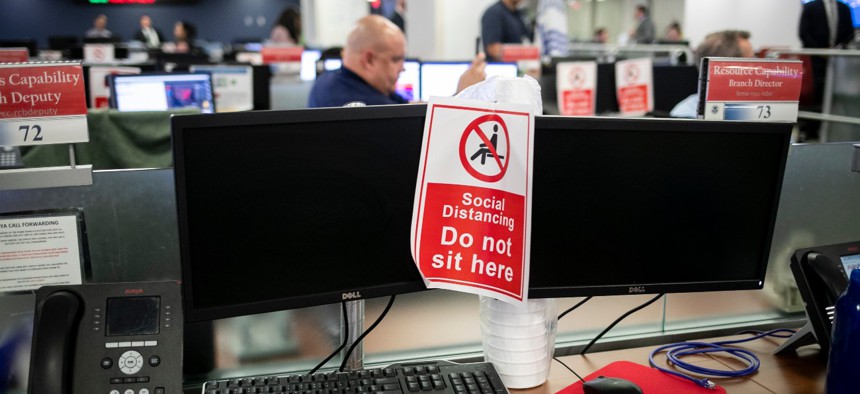
An empty desk shows a sign enforcing social distancing at the Federal Emergency Management Agency headquarters in April. Al Drago/The New York Times via AP, Pool
Trump Administration Lacks Comprehensive Plan to Reopen Federal Offices, GAO Says
Republicans say feds should swiftly go back to work: "It’s time to take our chances," one argues.
The Trump administration should boost its communication with federal employees and create clearer benchmarks for when agencies should call their workers back to their duty stations in the wake of the novel coronavirus pandemic, Democratic lawmakers and the government’s top watchdog said on Thursday.
The hearing—hosted by the Government Operations panel of the House Oversight and Reform Committee—highlighted a stark partisan division over how the federal government should operate in the coming weeks and months. Republicans repeatedly called on the federal government to “set an example” by bringing workers back to their offices, while Democrats, workforce advocates and the Government Accountability Office urged a more cautious, data-based approach.
The Trump administration has outlined guidance for federal agencies to bring back workers, issuing a memorandum in April that called on agencies to work in consultation with local leaders and public health officials to determine when to reopen offices. Agencies that have begun recalling employees to their offices have largely done so on a partial or regional basis, opening only some offices to certain groups of workers. Some headquarters offices in the capital region have begun bringing back certain employees, or allowed workers to come back on an optional basis.
Still, Rep. Gerry Connolly, D-Va., the subcommittee’s chairman, called the administration's reopening memo insufficient, noting it does not require personal protective equipment for all employees, plan for any widespread testing of federal workers or mention “what agencies should do in the event coronavirus cases spike again.”
Asked if the federal government had released a comprehensive, detailed plan for agency reopenings, Christopher Mihm, managing director for strategic issues at GAO, said, “We’ve not seen one.” He said GAO is working on a further review of agency responses to the pandemic and would go to each one to ask for its plans, seeking to identify any inconsistencies. While agencies can make their own mission-based decisions, he said they should coordinate at the regional level to ensure they are “sharing science” and “working with a common set of understandings.”
“We have to have confidence, and employees have to have confidence, that as we reopen they’ll be safe in their workplaces and be safe in their interaction with the public,” Mihm said, “and the public has to have confidence they will feel safe in their interactions with government.”
Rep. Jody Hice, R-Ga., said the Trump administration has been clear with the federal workforce on its expectations and has instructed agencies throughout the pandemic to provide “maximum flexibilities” to their employees. While agencies should continue telework where “necessary and appropriate,” he said, they should also move swiftly to bring employees back to work.
“It’s easy to talk about closing the economy when you’re with the federal government and you continue getting paid all the time,” Hice said.
Former Sen. Jim DeMint, R-S.C., and current chairman of the Conservative Partnership Institute, testified to the subcommittee that federal agencies should “set an example for the private sector.”
“We cannot continue with an idle nation,” DeMint said. “It’s time to take our chances and go back to normal.” He added the “key here is it’s very important at this point to allow federal government employees to return to normalcy.”
Connolly sharply disagreed with that approach.
Federal workers are “not pawns in a political tug of war,” he said. “They’re not symbols. They’re real human beings with families living in the community.”
Federal employee unions and groups such as the National Safety Council have pushed for a specific set of standards agencies should meet before calling workers back, such as sufficient personal protective equipment, testing capacity, office remodelings to enable social distancing and established benchmarks for COVID-19 spread in the relevant region. DeMint, however, dismissed those suggestions.
“We cannot add this regimen of all these things that have to be done before people can come back to work,” he said. “It seems more to be obstructing the idea of getting back to full employment at the local level.”
Jacque Simon, national policy director for the American Federation of Government Employees, said communication between agencies and their workers has been inconsistent. Some agencies have refused to engage with union representatives, she said, while others are implementing new policies without consultation. For example the Transportation Security Administration, she said, recently unilaterally moved to end its policy of providing paid “weather and safety leave” to employees at high risk for severe illness from COVID-19.
Connolly on Thursday proposed two new bills to assist the federal workforce during the pandemic: one would require agencies to post their reopening plans online, while the second would provide frontline workers with hazard pay and reimbursement for child care expenses.
GAO’s Mihm suggested some lessons from the pandemic would provide agencies with better operational capacity moving forward.
“From an operational and technical standpoint certainly it’s been normal, and if anything, it’s gotten a little better,” he said of agencies continuing to accomplish their missions while large swaths of their workforces conduct their duties remotely. “Agencies' experiences with telework suggest opportunities for increased availability in the future.”
Max Stier, president of the nonprofit Partnership for Public Service, echoed in written testimony that the government should draw permanent lessons from the pandemic.
“We need to seize upon this moment in history to help transform the way government works, and to make sure we do not go back to the old ways of doing business when new ways make more sense,” Stier said.







